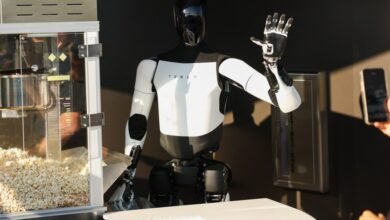OpenMind Aims to Become the Android OS for Humanoid Robots

▼ Summary
– OpenMind is developing OM1, a software layer for humanoid robots that acts as an open, hardware-agnostic operating system, likened to Android for robotics.
– The company introduced FABRIC, a protocol enabling robots to verify identity and share context and information with other robots for faster learning.
– Founder Jan Liphardt emphasizes the need for humanoid robots to interact more naturally with humans, requiring a new operating system that mimics human thinking.
– OpenMind plans to ship its first fleet of 10 OM1-powered robotic dogs by September 2024, focusing on rapid iteration based on user feedback.
– The startup recently raised $20 million in funding, led by Pantera Capital, to advance its goal of integrating robots into homes and refining their capabilities.
The race to develop advanced humanoid robots is accelerating, but one Silicon Valley startup is taking a different approach by focusing on the software that powers them. OpenMind, founded by Stanford professor Jan Liphardt, is creating what it calls the “Android of robotics”, an open, hardware-agnostic operating system designed to make robots think and interact more like humans.
While most companies concentrate on perfecting robotic limbs or sensors, OpenMind is working under the hood with its OM1 platform, a flexible software layer that could revolutionize how machines learn and communicate. The system is built to handle complex human-to-robot interactions, a necessity as humanoids move beyond factory floors into homes and workplaces.
Liphardt explains that traditional robots excel at repetitive tasks but struggle with dynamic, human-like engagement. “Machines are now entering a world where they must interact with people in entirely new ways,” he says. OpenMind’s solution includes FABRIC, a newly unveiled protocol that lets robots verify identities and share contextual data with each other, essentially enabling them to learn collectively.
For example, if one robot masters a language or skill, it can instantly transfer that knowledge to others, eliminating the need for individual training. “Humans take collaboration for granted, but machines need infrastructure to achieve the same level of coordination,” Liphardt notes. This approach could dramatically speed up robot adaptability in real-world environments.
The startup, which launched earlier this year, is already preparing its first real-world test: a fleet of 10 robotic dogs powered by OM1, set to deploy by September. Liphardt emphasizes the importance of real-user feedback, stating that rapid iteration will shape future improvements. “We expect users to tell us exactly what works and what doesn’t, then we’ll refine the technology at lightning speed,” he says.
Backed by a $20 million funding round led by Pantera Capital, with support from Ribbit, Coinbase Ventures, and other investors, OpenMind is positioning itself at the forefront of robotic intelligence. The company’s immediate focus is getting its technology into homes and workplaces, gathering insights to fine-tune its platform for broader applications.
“The key is matching today’s robotic capabilities with what humans actually need,” Liphardt adds. By prioritizing collaboration between machines and people, OpenMind aims to redefine how robots integrate into daily life, one software update at a time.
(Source: TechCrunch)





